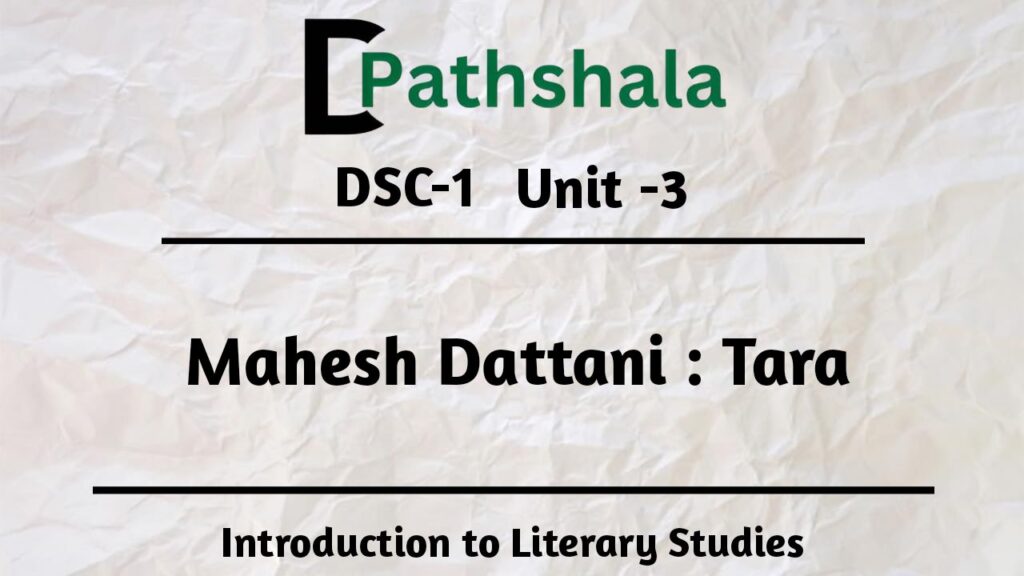In this post, notes of Unit 2 (Reading Poetry – John Milton: ‘On his Blindness’) from DSC – 1 (Introduction to Literary Studies) are given which is helpful for the students doing graduation this year.
John Milton: ‘On His Blindness summary’
About John Milton

John Milton (1608–1674) was an English poet, polemicist, and civil servant, best known for his epic poem “Paradise Lost.”
He lived during a tumultuous period in English history, and his life and works were deeply influenced by the political, religious, and social context of the time.
Birth and Family:
John Milton, a famous English poet, was born on December 9, 1608, in Bread Street, London, England. His family was not very rich, but they valued culture and education, which helped him in his writing.
Family Background:
- Father:
- John Milton Sr. was a scrivener (a person who writes legal and financial documents) and a music composer.
- He was cut off from his wealthy Catholic family for becoming Protestant, which influenced Milton’s own religious beliefs and themes in his writing.
- Mother:
- Sarah Jeffrey, his mother, was known for her strong faith and kindness. She came from a family of merchants.
- Siblings:
- Milton had two siblings who lived into adulthood:
- Anne Milton, his older sister, who got married and had children.
- Christopher Milton, his younger brother, who became a lawyer and supported the Royalist side in the English Civil War, while John supported the Commonwealth.
Growing up in a well-educated and religious family helped shape Milton’s thinking and writing.
Early Life of John Milton :
Education of john milton:
John Milton had a great education that helped him become a strong writer and thinker. His schooling focused on classic literature, philosophy, and theology.
Early Education of john milton:
- Home Tutoring
- Milton was taught at home by private tutors, including Thomas Young, a Scottish minister who taught him classical languages and literature.
- St. Paul’s School, London (1620-1625)
- Milton attended St. Paul’s School, a well-known grammar school, where he studied Latin, Greek, and Hebrew a lot.
- He showed great talent and worked hard, earning the nickname “The Lady of Christ’s” because of his gentle looks and serious attitude.
Higher Education of john milton:
- Christ’s College, Cambridge (1625-1632)
- Milton went to Christ’s College, University of Cambridge, planning to become a clergyman.
- He received a Bachelor of Arts degree (1629) and later a Master of Arts degree (1632).
- While at Cambridge:
- He did very well in Latin poetry and speaking.
- He had a small conflict with school leaders, which led to a short suspension, but he returned to finish his studies.
Post-Academic Studies of kohn milton:
- Independent Study (1632-1638)
- After leaving Cambridge, Milton chose not to go into the Church and focused on becoming a poet.
- For almost six years, he studied hard at his family home in Horton, Buckinghamshire.
- He read a lot about theology, philosophy, history, literature, and science, and learned several languages, including Italian, French, and Old English.
- This time of focused study prepared him for his later great writings.
Milton’s education shows the Renaissance idea of a well-rounded person, allowing him to create important and lasting works.
| Related | |
|---|---|
| it must flow a life in theatre habib tanvir summary | A.N. Kaul’s essay “A New Province of Writing” notes |
Political and Religious Context of john milton:
Stuart England:
Milton lived during a time when England was ruled by the Stuart kings, which was a period of political and religious conflict, especially under James I and Charles I.
Civil War (1642–1651):
The English Civil War started between the Royalists, who supported the king, and the Parliamentarians, who backed Parliament. Milton was on the side of the Parliamentarians and wrote many pamphlets to support their cause for a republic.
Interregnum:
After King Charles I was executed in 1649, England became a republic called the Commonwealth of England. Milton worked as a Secretary for Foreign Tongues in Oliver Cromwell’s government.
Restoration (1660):
In 1660, the monarchy was restored when Charles II returned, ending the Commonwealth. Milton, who had supported the republic, faced political and legal problems.
| Related | |
|---|---|
| Narratology Form and Function of Narrative summary | Introduction to versification and poetic syntax |
John Milton’s famous works:
Early Works:
Milton wrote many poems and essays before the Civil War, like “L’Allegro,” “Il Penseroso,” and “Comus.”
Pamphlets and Prose:
During the Civil War, Milton wrote many political and religious pamphlets, including “Areopagitica,” which defends free speech.
Paradise Lost (1667):
His most famous work, “Paradise Lost,” is a long poem that tells the biblical story of the fall of man. It looks at ideas of free will, disobedience, and evil.
Paradise Regained and Samson Agonistes (1671):
Milton’s later major works include “Paradise Regained” and the dramatic poem “Samson Agonistes.”
| Related | |
|---|---|
| Emily Dickinson 341 After Great Pain Summary | Composed Upon Westminster Bridge By William Wordsworth Summary |
Blindness and Later Life of John Milton:
Blindness:
Milton slowly lost his eyesight and was completely blind by 1652. Even though he couldn’t see, he kept writing with the help of assistants.
Legacy:
John Milton made important contributions to literature and ideas about government. His focus on personal freedom and his writing have made him a significant figure in English literature.
Death of John Milton:
John Milton passed away on November 8, 1674, in London, at 65 years old. Many important people attended his funeral, honoring his work in literature and politics.
John Milton’s life and writing show the mix of politics, religion, and literature during an important time in English history. His influence is still seen today in how people study and appreciate his work.
| Related | |
|---|---|
| Short Summary of Tara by Mahesh Dattani | Where the Mind is Without Fear summary, Analytics, Poetic Devices |
On His Blindness Summary:

Stanza 1:
Milton talks about his sadness over being blind, which he sees as a gift from God that he has lost. He compares his sight to something very valuable, a "light" that he loved, but now he lives in darkness. He feels sad that he can't use this gift to serve God like he used to.
Stanza 2:
The poet thinks about how God might judge people based on how they use their gifts. He wonders if God wants people to be active and if He would punish those, like Milton, who can't serve because of things they can't control. The idea of fairness and what God expects is important in this part.
Stanza 3:
Milton finds peace by changing how he thinks about service. He realizes that God doesn’t just want people to do physical work. He learns that being patient and accepting God's plan can also be a way to serve. The last lines show a feeling of hope and trust in God's wisdom.

on his blindness Analysis:
- Theme of Loss and Acceptance:
- The poem's central theme is Milton's loss of eyesight and his struggle to accept this loss. The initial stanzas are marked by a sense of mourning and questioning God's purpose.
- Religious Reflection:
- The poem is deeply rooted in religious themes, as Milton contemplates his relationship with God and the nature of divine justice. It reflects Milton's Puritan beliefs and his attempt to reconcile his faith with his personal challenges.
- Talent and Service:
- Milton explores the concept of talent as a gift from God and questions whether God expects active service in return. The poem grapples with the idea of using one's talents for God's glory and the potential guilt associated with not being able to do so.
- Redefined Service:
- The resolution in the final stanza marks a shift in Milton's understanding of service. He concludes that patience and humble acceptance of God's will, even in the face of adversity, can be a form of faithful service. This realization brings a sense of peace and hope.
- Use of Sonnet Form:
- The poem is a Petrarchan or Italian sonnet, consisting of an octave (eight lines) and a sestet (six lines). The octave presents the problem or conflict, while the sestet provides a resolution or a shift in perspective.
- Tone and Emotion:
- The tone of the poem is initially mournful and reflective, but it transforms into one of acceptance and submission to divine will. Milton's emotional journey is evident in the shifting moods throughout the sonnet.
"On His Blindness" is a powerful exploration of faith, loss, and acceptance. Through this sonnet, Milton grapples with profound questions about the nature of service to God and finds solace in redefining his understanding of what it means to serve faithfully despite physical limitations.
| Related | |
|---|---|
| Emily Dickinson 341 After Great Pain Summary | Composed Upon Westminster Bridge By William Wordsworth Summary |
On his blindness central idea:
The main idea of "On His Blindness" is about the poet thinking deeply about his blindness and the questions it brings about faith and life. The poem talks about losing sight, believing in God, fairness from God, and how to serve God.
Loss:
The poem starts with Milton feeling sad about losing his sight. He refers to his vision as a special gift from God. His sadness over losing the "light" in his eyes shows how much he values his sight.
Faith in God:
Milton struggles to connect his beliefs with his blindness. The poem shows his strong religious feelings. He questions if God wants people to serve in visible ways and thinks about what fairness from God means.
Service to God:
A key part of the poem is about how to serve God. At first, Milton thinks God wants people to do physical tasks. But as the poem goes on, he realizes that being patient and accepting what God wants can also be a way to serve faithfully.
Message of On His Blindness:
The "on his blindness" shares important messages about the poet's personal struggles and larger questions about faith.
Acceptance of Hardship:
One main message is to accept hardships and find meaning in difficult situations. Milton, who loses his sight, learns to accept it with humility and patience.
Reconsidering Service:
The poem suggests that we should rethink what it means to serve God. Even if someone's actions are limited by their situation, qualities like patience and acceptance are still valuable ways to serve.
Trust in God's Plan:
Through the poem, Milton learns to trust in God's plan. Accepting his blindness becomes a sign of faith, as he realizes that God's understanding is greater than human understanding.
Spiritual Strength:
"On His Blindness" shows the idea of being spiritually strong during tough times. Milton turns his sadness into a renewed faith and a new view of service, which shows his spiritual strength.
Hope in Acceptance:
The last lines of the sonnet offer a hopeful message about accepting God's will. By being patient and understanding human limits, Milton finds peace and hope for the future.
Overall, "On His Blindness" is a thoughtful poem that explores human experiences, faith, and accepting things we cannot change. Through his journey, Milton shares lasting messages about strength, redefined service, and trust in God.
| Related | |
|---|---|
| Aristophanes Lysistrata Summary, Analysis, Poetic Devices | Sophocles Antigone Summary and Analysis |
Form of 'On His Blindness’ :
- Sonnet Type:
- "On His Blindness" is a Petrarchan sonnet, a form that originated with the Italian poet Petrarch. It contrasts with the Shakespearean or Elizabethan sonnet, which has three quatrains followed by a rhymed couplet.
- Total Lines:
- The sonnet consists of 14 lines.
Structure of 'On His Blindness’:
Octave (First Eight Lines):
Rhyme Scheme:
- The octave follows the rhyme scheme ABBAABBA.
- This means that the first and fourth lines rhyme with each other, the second and third lines rhyme with each other, and the fifth and eighth lines rhyme with each other.
Presentation of Conflict:
- The octave typically presents a problem or conflict, and in "On His Blindness," this section is where Milton expresses his lamentation and explores the initial questions about the purpose of his blindness and his ability to serve God.
Sestet (Last Six Lines):
- Rhyme Scheme:
- The sestet follows the rhyme scheme CDCDCD.
- The rhyme pattern in the sestet is more varied, with no repeated rhymes from the octave. This helps create a shift in tone or perspective.
- Resolution or Shift:
- The sestet often provides a resolution to the conflict presented in the octave. In "On His Blindness," this section marks the shift in Milton's thinking, where he comes to a realization about the nature of service to God and finds a sense of acceptance.
Meter:
- Iambic Pentameter:
- The poem is written in iambic pentameter, a metrical pattern where each line consists of five iambs (pairs of syllables with the stress on the second syllable).
- This meter gives the poem a rhythmic and flowing quality.
Other Structural Considerations:
- Volta (Turn):
- The sonnet form often includes a volta or "turn," which is a shift in tone, perspective, or argument. In "On His Blindness," the volta occurs between the octave and the sestet, signaling the poet's change in thought from lamentation to acceptance.
- Couplet:
- The final two lines of the sonnet often form a rhymed couplet. In "On His Blindness," the couplet serves to conclude the poem and encapsulate the poet's final thoughts on the theme of service and submission to God's will.
In summary, the form and structure of "On His Blindness" follow the traditional Petrarchan sonnet pattern, employing the octave-sestet division, specific rhyme schemes, and iambic pentameter to convey John Milton's contemplation on his blindness and its spiritual implications.
literary devices in on his blindness
John Milton's "On His Blindness" employs various literary devices and a rich use of language to convey the poet's deep emotions, contemplation, and spiritual journey. Here are details on the literary devices and language used in the poem:
- Metaphor:
- The opening line contains a metaphor: "When I consider how my light is spent."
- The use of "light" metaphorically refers to both Milton's eyesight and his life's purpose or talent.
- Personification:
- The eyes are personified in the line, "And that one Talent which is death to hide."
- The talent is personified as something that can be hidden or lost.
- Enjambment:
- The poem features enjambment, where lines flow into each other without a pause, creating a continuous and flowing rhythm.
- For example, "When I consider how my light is spent, / Ere half my days in this dark world and wide."
- Alliteration:
- Alliteration, the repetition of consonant sounds at the beginning of words, is present in lines such as "When I consider how my light is spent."
- The repeated "l" sound emphasizes the contemplative mood of the poem.
- Assonance:
- Assonance, the repetition of vowel sounds within nearby words, is found in lines like "But, patience, to prevent."
- The repetition of the short "e" sound creates a musical quality in the language.
- Symbolism:
- The "Talent" mentioned in the poem symbolizes not just eyesight but also the poet's abilities and purpose in life.
- Irony:
- There is an ironic element in the line "Doth God exact day-labor, light denied?" as Milton questions whether God demands active service when he is deprived of the physical ability to perform it.
- Rhetorical Question:
- The poem contains rhetorical questions such as "Doth God exact day-labor, light denied?" These questions are not meant to be answered directly but serve to emphasize the poet's internal struggle.
Language used in On his Blindness:
- Archaisms:
- Milton uses some archaic language and phrasing, reflective of the time in which he lived. For example, "Doth" instead of "Does," and "Ere" instead of "Before."
- Elevated Diction:
- The poem employs elevated or formal language, characteristic of Milton's style, contributing to the serious and contemplative tone.
- Biblical Allusion:
- The reference to the biblical concept of talents comes from the Parable of the Talents in the Gospel of Matthew. This allusion adds a religious layer to the poem.
- Imagery:
- The use of visual imagery is evident in lines like "When I consider how my light is spent" and "Haste, while the morning hours thy candles waste."
- These images enhance the reader's understanding of the poet's internal struggle and the fleeting nature of time.
- Shift in Tone:
- The poem undergoes a shift in tone from despair and questioning in the octave to acceptance and resolution in the sestet. This shift is conveyed through the choice of language and diction.
- Contrast:
- The poem contrasts the physical loss of eyesight with the internal, spiritual understanding of service to God. This contrast is expressed through carefully chosen words and phrases.
"On His Blindness" is a masterful use of language and literary devices, blending emotional depth with intellectual contemplation. Milton's choice of words, metaphors, and rhetorical devices contributes to the richness and complexity of the poem, allowing readers to delve into the poet's introspective journey and theological reflections.
Click here for full Peom - On His Blindness Full Text



